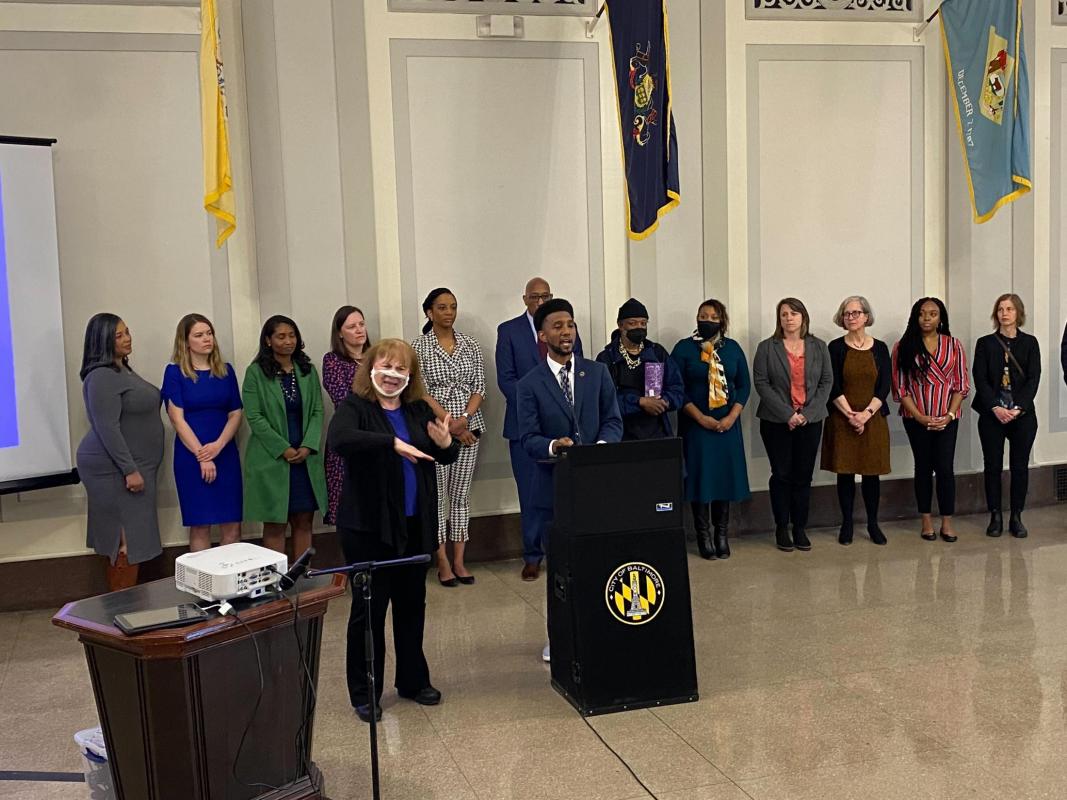
Back when he was nine years old growing up in Park Heights, Brandon Scott recalls, he had a friend who was ill-prepared for the arrival of winter. Money was tight, and his friend’s family couldn’t afford to buy him a new coat at the time, so the Scott family gave him an extra one out of their closet. That small gift, a piece of outerwear worth maybe $100, helped fill a need—keeping his friend warm—and also gave his family a bit of extra wiggle room in their winter budget.
As Mayor Scott sees it, the ethos behind Baltimore’s new $5.5 million guaranteed income pilot program isn’t so different: it’s money to fill in the gaps and cover basic necessities that many families might take for granted. Applications open May 2, and starting this summer, the city will be giving $1,000 per month to 200 parents or guardians ages 18 to 24 who earn up to 300 percent of the federal poverty line, which is $27,750 for a family of four. The money will come with no strings attached, meaning parents and guardians can spend it as they see fit for the next two years.
For a given family, that money could go toward making rent and staving off an eviction, or be used to buy a car instead of having to ride the bus for multiple hours a day to get to work, Scott predicted in March. “This is an opportunity to help those families, those children, to have a better life.”
Baltimore will be the latest city to test whether modestly padding an insufficient social safety net can demonstrably boost quality of life for families in need. Last February, Scott joined Mayors for a Guaranteed Income (MGI), a growing coalition of city leaders committed to providing direct cash payments as a base income floor for citizens in need. MGI now counts 62 member city mayors and administrators, and 28 cities have launched or completed pilot programs tailored to a range of recipients. (Guaranteed income, it’s worth noting, is narrower in scope than universal basic income, which proposes giving cash to all adults rather than to a targeted audience.)
Critics have long derided such cash payments as misguided handouts that could suppress recipients’ commitment to keep working. But early research has shown promising results that say otherwise.
Stockton, California—where a pioneering, two-year, $500-per-month pilot program recently finished—found participating families had more full-time employment than before the program began and, compared to non-recipient families, better financial stability and overall improved moods. Early results out of tiny Hudson, New York, which is also giving $500 per month to families, showed a doubling in employment and improved health and relationship outcomes among recipients.
The guaranteed income (GI) results from Stockton are in:
1. Employment & Productivity ⬆️
2. Well Being ⬆️ and stress ⬇️
3. It allowed people to pay off debt
4. The money was spent on necessities and not drugs.
We need a guaranteed income policy. @stocktondemo @mayorsforagi pic.twitter.com/utB60duQN6 — Michael Tubbs (@MichaelDTubbs) March 3, 2021
Baltimore is funding its program with $4.8 million from the city’s $641 million tranche of the American Rescue Plan Act, plus private and mayor’s office funds to cover another roughly $700,000 in administrative costs.
The key players:
The Guaranteed Income Steering Committee—made up of 20 researchers, social welfare organization leaders, philanthropists, and others—has been meeting bi-weekly since June 2021 to determine the pilot design and follow-up research topics. The group’s primary duties have been to gather public input—including conducting more than 500 individual surveys and five focus groups—as well as to determine the timeline, size of cash payments, and target population. The Mayor’s Office of Children and Family Success has brought on other partners to run the pilot itself. The nonprofit CASH Campaign of Maryland is serving as its administrator, and Steady, a Shaquille O’Neal-backed fintech startup out of Atlanta, will distribute the monthly payments—but the committee will continue serving in an advisory capacity for the next two years.
Coincidentally, this work happened to kick off just as COVID-19 unleashed economic havoc on families across Maryland and nationwide. Open Society Institute-Baltimore Executive Director Danielle Torain, who served as the steering committee’s co-chair, says OSI had already been helping the city issue emergency cash payments and prevent evictions. She and other members had observed young parents, particularly those without strong family and support networks, were struggling to pay rent, buy groceries, cover child care, and maintain reliable transportation—“just taking care of the small things that many of us could otherwise take for granted,” Torain says.
Who will benefit:
The committee considered various audiences for the pilot, including people returning from incarceration and squeegee workers. But eventually “the group consensus came back to young parents who are new, who are most fragile economically, who are trying to figure out how they can use this to stabilize their families,” says Joe Jones, the committee’s other co-chair and the founder and president of the Center for Urban Families near Penn North.
The chosen audience will generate plenty of data to study, including how extra monthly income impacts families’ access to and use of child care, as well as parent-child engagement and resilience to financial emergencies and other unexpected costs. More broadly, the follow-up research presents a chance for Baltimore to be part of a discussion about guaranteed income and economic mobility—an area where Baltimore has underperformed, due in part to its historic legacy of redlining—says Lorraine Dean, a committee member and associate professor of epidemiology at Johns Hopkins University’s Bloomberg School of Public Health.
“There’s a false argument in even thinking about this as a handout,” says Dean, who studies how social and economic factors affect family health. “Most people who are low-income do work. In fact, many times they will be working multiple jobs if they can, and if they’re not, it’s because they’re taking care of children because child care is so expensive.”
We love to see it! 💫 https://t.co/5cnziMcgih — Mayors for a Guaranteed Income (@mayorsforagi) April 5, 2022
Deep roots:
Baltimore’s and other cities’ pilot programs are a novel movement, though the push for a publicly provided income floor in the U.S. has deeper roots. The first formal U.S. guaranteed income proposal dates back to President Lyndon Johnson and his declaration of an “unconditional war on poverty” in 1964, explains Robert Moffitt, the Krieger-Eisenhower Professor of Economics at Johns Hopkins University. A commission from his administration recommended creating a base income for Americans, but Johnson opted instead for social safety net programs like Medicaid, Medicare, food stamps (now called Supplemental Nutrition Assistance Program, or SNAP) and more, many of which are still active.
These programs catalyzed other policy proposals, including those from Johnson’s successor, President Richard Nixon, who proposed an ahead-of-its-time Family Assistance Plan that would have provided an annual guaranteed income of $1,600 (nearly $12,000 in 2022 dollars) for a qualifying family of four. But Congress didn’t bite on the legislation. Conservatives argued it would dissuade people from working, while Senate Democrats said it wasn’t enough money. The conservative argument gained traction during the 1970s and during the Reagan era, with the late Republican president himself using the “welfare queen” trope in his campaigns.
During the 1990s “the pendulum swung the other way,” Moffitt says, with leaders from both sides of the aisle working to dismantle anti-poverty programs. The Clinton administration made good on a pledge to “end welfare as we know it” as the president signed a bill passed by Congress in 1996. The legislation eliminated the Families with Dependent Children program, which since 1935 had provided cash assistance to families with children, and replaced it with Temporary Assistance for Needy Families (TANF), which drastically reduced funding and began requiring recipients to show proof they are working.
What remains today at the federal level is what Moffitt says are an insufficient collection of federal programs—just Medicaid and SNAP for most poor families, Moffitt says—that make up the work-based safety net, supplemented by the Earned Income Tax Credit every tax season. Poverty remains widespread, with 11 percent of Americans and 20 percent of Baltimoreans living below the federal poverty line, per the latest Census data.
“Politically, I think that the interest in the guaranteed income is the result of a perceived failure of our current safety net,” Moffit says. “It is not providing anything more than food stamps and Medicaid, and low-income families need more than that, both for their short-term needs and their long-term futures.”
It's been a year since the #AmericanRescuePlan became law, and because of that funding, mayors across the U.S. have been able to make historic amounts of cash available to families to help them make ends meet during the pandemic. The results are clear: an income floor works. — Mayors for a Guaranteed Income (@mayorsforagi) March 11, 2022
The federal government flirted with expanding the safety net during the first two years of the COVID-19 pandemic with stimulus checks and the expanded child tax credit, which grew from $2,000 to $3,600 per child under six years old and $3,000 per child up to age 17. But the effort was fleeting—relief checks for $1,200, $600, and $1,400 came and went. And despite a push from the Biden administration to extend it, Congress allowed the expanded child tax credit to dissolve after just six months.
Sukhi Samra, MGI’s Stockton-based executive director, says that political fallout and the pandemic have only intensified families’ needs.
“As we’re going on to year three of the pandemic,” Samra says, “a guaranteed income is a way to test out this solution for these evergreen problems of economic security and poverty.”
Of the Scott administration’s soon-to-launch pilot, she says, “Baltimore gives us another opportunity to understand how guaranteed income can act as a floor for folks who are raising children.”
Stakeholders in Baltimore hope to see proof in the data that an extra $1,000 monthly boost can help families achieve greater self-sufficiency, improved health, and other quality-of-life outcomes in two years’ time (if not sooner). Jones, of the Center for Urban Families, hopes the study of the results could even help inform statewide or federal policymaking to bolster the safety net.
Spreading the word:
To kick this off right, they’ll have to make sure the right families know to apply. Torain expects the mayor’s office to lean on a community network with a “deep reach,” including community groups and workforce training programs in direct contact with clients who could qualify. The city will be launching its online application in early May, and a mix of social media, conventional neighbor-to-neighbor word of mouth, and traditional news coverage should all help to get the word out, she says.
Jones looks forward to assessing the effects of financial empowerment for a young generation of families looking to level up. There will be doubters, he predicts, but “we want to move people who are unsure to be supportive, and the data is what we will use to do that,” he says.
“These are relatively small investments in people—adults who are responsible for little people. To me, as a society, that value proposition—as we think about investments in hard infrastructure, as we continue to bridge the gap from a technology standpoint—is, what does it mean to give parents some real support with these unrestricted payments, to give them some autonomy over their decision-making?”
Mayor Scott sees a chance to prove a point: “I think it’s time for us to start to say to those folks who continue with outdated right-wing talk points—racially motivated things, gaslighting—that that’s [all that] they are. This isn’t a handout. It’s a hand up for these people—because these are working people.”
